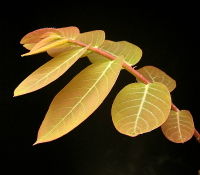
Within‐community variation of interspecific divergence patterns in passerine gut microbiota
Sign Up to like & getrecommendations! Published in 2022 at "Ecology and Evolution"
DOI: 10.1002/ece3.9071
Abstract: Abstract Gut microbiota (GM) often exhibit variation between different host species and co‐divergence with hosts' phylogeny. Identifying these patterns is a key for understanding the mechanisms that shaped symbiosis between GM and its hosts. Therefore,… read more here.
Keywords: gut; host species; species specificity; divergence ... See more keywords

The evolution of (non)species-specific pheromones
Sign Up to like & getrecommendations! Published in 2020 at "Evolutionary Ecology"
DOI: 10.1007/s10682-020-10046-0
Abstract: Pheromones are chemical signals that elicit innate and stereotyped responses in conspecifics, often with intricate species specificity. The remarkable diversity of pheromones has made them particularly useful for studying the physiological and evolutionary mechanisms underlying… read more here.
Keywords: evolution; evolution non; species specificity; non species ... See more keywords

Rational design, chemical synthesis and biological evaluation of novel biguanides exploring species-specificity responsiveness of TAAR1 agonists.
Sign Up to like & getrecommendations! Published in 2018 at "European journal of medicinal chemistry"
DOI: 10.1016/j.ejmech.2018.01.059
Abstract: The design of novel chemical classes acting towards several G-protein-coupled receptors (GPCRs) represents a leading strategy in drug discovery, aimed at deriving effective and safe candidates for further assessment. During the last years, TAAR1 arose… read more here.
Keywords: species specificity; chemistry; chemical; specificity responsiveness ... See more keywords

Species specificity of rat and human α7 nicotinic acetylcholine receptors towards different classes of peptide and protein antagonists
Sign Up to like & getrecommendations! Published in 2018 at "Neuropharmacology"
DOI: 10.1016/j.neuropharm.2018.07.019
Abstract: ABSTRACT Peptide and protein neurotoxins, such as &agr;‐conotoxins from Cone snails and &agr;‐neurotoxins from snake venoms, are excellent tools to identify distinct nicotinic acetylcholine receptor (nAChR) subtypes. Here we compared the rat/human species specificity of… read more here.
Keywords: k11a txib; peptide protein; txib h5d; species specificity ... See more keywords

Diversity and species-specificity of brood pollination of leafflower trees (Phyllanthaceae: Glochidion) by leafflower moths (Lepidoptera: Epicephala) in tropical Southeast Asia (Cambodia)
Sign Up to like & getrecommendations! Published in 2021 at "Plant Diversity"
DOI: 10.1016/j.pld.2021.07.001
Abstract: Abstract Glochidion (Phyllanthaceae; leafflower trees) is a genus of trees which is widely reported to be pollinated by leafflower moths (Gracillariidae: Epicephala) in temperate and subtropical Asia, Australia, and the Pacific islands. However, the pollination… read more here.
Keywords: leafflower trees; asia; glochidion; species specificity ... See more keywords

81 Species-specificity in metmyoglobin reduction
Sign Up to like & getrecommendations! Published in 2019 at "Journal of Animal Science"
DOI: 10.1093/jas/skz053.063
Abstract: Myoglobin is the primary sarcoplasmic protein responsible for meat color. Previous research has reported that myoglobin oxidation is species-specific. Metmyoglobin reducing activity is an inherent property to limit myoglobin oxidation. However, limited research has determined… read more here.
Keywords: myoglobin; metmyoglobin reducing; metmyoglobin reduction; species specificity ... See more keywords

46 Species-specificity in metmyoglobin reduction
Sign Up to like & getrecommendations! Published in 2019 at "Journal of Animal Science"
DOI: 10.1093/jas/skz053.191
Abstract: Myoglobin is the primary sarcoplasmic protein responsible for meat color. Previous research has reported that myoglobin oxidation is species-specific. Metmyoglobin reducing activity is an inherent property to limit myoglobin oxidation. However, limited research has determined… read more here.
Keywords: myoglobin; metmyoglobin reducing; metmyoglobin reduction; species specificity ... See more keywords

Exploiting species specificity to understand the tropism of a human-specific toxin
Sign Up to like & getrecommendations! Published in 2020 at "Science Advances"
DOI: 10.1126/sciadv.aax7515
Abstract: Overcoming the species specificity of the MRSA toxin LukAB with a novel mouse model establishes a role for LukAB in vivo. Many pathogens produce virulence factors that are specific toward their natural host. Clinically relevant… read more here.
Keywords: species specificity; lukab; cd11b; toxin ... See more keywords